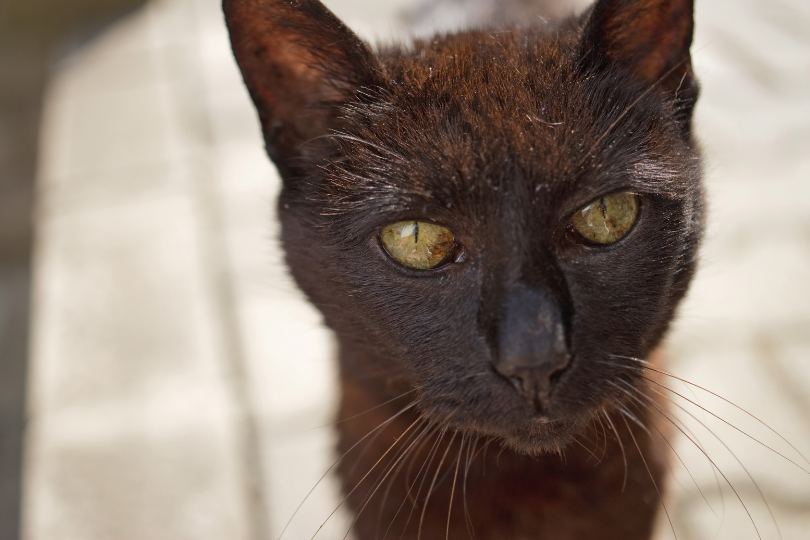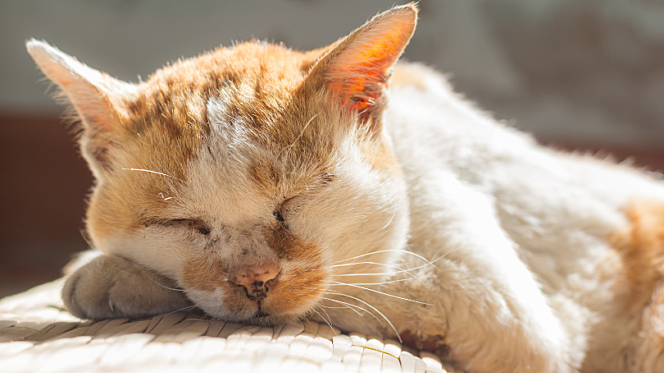As with humans, a cat’s dietary and health care needs will change as they age.
The average cat has a lifespan of 15 to 20 years, but a cat is considered senior once they are over seven to eight years of age. At 11 years old, cats have reached retirement age, at 14 years old, a cat is thought to be in its seventies. These figures are not based on their lifespan, but rather on their biology and the physical changes that start to happen in the later part of their lives.
Your cat’s age in human years will vary based on weight and care. Cats who live primarily indoors will age better than outdoor cats.
You can help your best friend age positively by looking out for any changes to their health and by making regular visits to your vet. Advances in veterinary treatment and improved nutrition for cats have contributed to a longer life expectancy for indoor only cats.
Always pay attention to changes in your cat’s behaviour. Cats are very private creatures, and they cannot always tell you when something is wrong. Most animals have evolved to hide the signs when they are sick until their illness is quite advanced. Here are some of the common problems that your senior cat may experience.
Weight loss and gain
Obesity in pets is entirely avoidable and there are many ways to ensure that your cat remains as fit and energetic as possible. Like humans, cats will gain weight when they consume too many calories and do not burn them off with exercise.
Older cats will need food that they can easily digest but still provides them with good nutrition.
A cat will store excess calories as fat when they are fed too many treats, or human foods which are not suitable for pets, in combination with becoming less active as they age.
If you are unsure of what to feed your senior kitty, consult your vet who will suggest an appropriate food for their age and individual health condition.
It is essential to monitor your cat’s weight. There are health risks associated with weight gain which can lead to a lower life expectancy. Obesity in cats can lead to arthritis, diabetes, respiratory problems and urinary tract disease.
Certain breeds of cat are genetically predisposed to becoming heavy set as they age. It is difficult for an overweight cat to move freely with ageing joints and when arthritis has set in.
Weight loss in ageing cats can also be an indicator of a serious underlying illness, such as thyroid disease.
Your vet will weigh your cat and judge whether they are within the appropriate weight range for their build and age. In a healthy cat, all parts of its body will appear well proportioned, with an even muscle mass. The ribs, spine and pelvic bones can be felt but are not easily visible. A cat who is the right weight will have minimal abdominal fat and an obvious tuck in its abdominal region.
Signs your cat is overweight:
- You are unable to feel your cat’s ribs, spine and pelvic bones
- You cannot see that your cat has a visible waist
- Your cat has extensive and visible abdominal fat
Signs your cat is underweight:
- Your cat’s ribs, spine and pelvic bones are easily visible
- You can easily feel your cat’s ribs
If you think your cat might not be at a healthy weight, you should consult your vet about a dietary plan.
Tumours, lumps and bumps
If you notice any lumps or bumps on your cat’s body consult your vet so they can identify whether they are harmful or not. A vet may suggest removing the tumour with surgery if it changes or gets bigger.
Fatty tumours, called lipomas are more often seen in older or overweight cats. They are not cancerous and will not need to be removed unless they are affecting how your cat can move around.
Mast cell tumours can also appear on your cat’s skin, usually on the head or neck. They may be itchy or red. About 10% of these tumours will be cancerous.
Fibrosarcomas are aggressive cancerous tumours that can appear anywhere on your cat’s body.
Arthritis
Arthritis is the inflammation and degeneration of the joints. Arthritis results in the cartilage lining of the joints wearing down which causes swelling and pain. Arthritis is easily confused with the signs of ageing in cats.
If your cat suffers from arthritis, they may experience worse pain after resting, vigorous exercise or during cold weather. You can help your cat by putting their bedding and toys in an area that they can easily access.
There is no cure for arthritis but when properly managed, the progression of this disease can be slowed. Your vet may suggest a course of anti-inflammatory medication, nutrition management and other ways to help your cat remain comfortable in old age.
Here are some indicators that your cat may be suffering from arthritis:
- Stiffness or slowness when getting up, sitting or lying down, especially after they have been resting
- Your cat is unwilling to jump and has difficulty going up or down stairs
- They are reluctant to exercise and you notice a reduction in their level of activity
- Your cat drags its back legs
- Your cat has worn toenails or is reluctant to groom itself. Cats are usually fastidious when it comes to cleaning themselves. Take note or the condition of their fur, does your friend look unkempt or dirty?

Chronic Kidney disease
Kidney disease is one of the most prevalent and painful conditions in senior cats. As they age, many cats experience kidney damage. Their kidneys degenerate and are then unable to filter toxins and waste from their bodies, which build up in the bloodstream.
There is no cure but if diagnosed early, kidney disease can be effectively managed. Damage to the kidneys is irreversible but your vet can advise you of the medical treatments available to support the remaining healthy part of your cat’s kidneys.
Feline lower urinary tract disease can refer to different conditions that can affect your cat’s bladder and urethra, such as the development of crystals and stones. Urinary tract diseases are less serious but can lead to the development of chronic kidney disease, so it is important to take your elderly cat for regular vet check-ups, especially if you notice they are not feeling well and there has been a change in their toileting habits.
If your cat exhibits any of the following behaviours, contact your vet immediately:
- Urinating more frequently or not using the litter tray
- Excessive thirst and drinking
- Difficulty and pain while urinating
- Meowing or another form of vocalisation while trying to urinate
- Urinating outside the litter box, whether it be next to the litter box, in another room, in the shower, on beds, in shoes etc.
- Blood in their urine
- Weight loss
- A loss of appetite
- Vomiting
- Lethargy
- A hard or firm tummy
- Poor coat quality
- Excessive grooming of or inflammation around the genital area
Dental care
Cats and people both need to maintain good dental hygiene. Unfortunately, unlike humans, cats cannot brush their teeth twice daily.
Many cats over the age of four years will suffer from some form of dental disease. Gingivitis in cats and people is the inflammation of the gums caused by the build-up of plaque, above and below the gum line. Plaque is made up of food particles, saliva and bacteria.
Gingivitis has serious consequences for cats. If not removed, plaque will calcify into tartar and the disease will progress, leading to the destruction of the supportive tissues of the teeth, bone damage and infection.
Gingivitis results in your cat experiencing bad breath, oral pain which can affect their ability to eat, and the loss of their teeth.
Your vet will examine your cat’s teeth and gums to identify the development of dental disease. They can suggest a diet to help manage the condition. If your kitty has existing dental disease, they will require a scale and clean procedure under a general anaesthetic with the possible removal of any diseased teeth.
Here are some common signs that your senior cat has dental disease:
- Bad breath
- Discoloured teeth
- Loose teeth
- Excessive drooling
- Pawing at the mouth
- Inflamed or blood-stained gums
- Reluctance to chew or eat at all
- Dropping food from their mouth
- Pain when touched around the head
- Facial swelling
- Changes in behaviour such as increased aggression or fatigue
- Receding gums
Feline hyperthyroidism
Feline hyperthyroidism is the most common hormonal disorder in cats and usually affects cats over eight years of age. It is caused by the increased secretion of the thyroid hormone, which is usually caused by a benign tumour in your cat’s thyroid gland.
In a small percentage of cases, this tumour may be malignant, and the cancer can spread to your cat’s other organs.
Your vet will perform a blood test to accurately identify the condition as hyperthyroidism can look clinically similar to many other conditions, such as renal failure.
The most common signs of feline hyperthyroidism are weight loss and increased appetite.
Clinical signs of the disease include:
- Hyperexcitability or anxiety
- Palpable goitre (a vet can feel the enlarged thyroid gland in your cat’s neck)
- Vomiting or diarrhoea
- A rapid heartbeat or thumping heart
- Increased drinking or urination
- Fluid retention relating to heart disease
- Some cats experience periods of decreased and increased appetite
As your cat ages, it’s a good idea to keep an eye out for any of the above issues. If you think they might be appearing in your cat, book an appointment with your vet.
Sadly, pets age. But if you keep on top of these issues you can ensure your pet lives a long, happy life!
For more information about your pet’s health, click the button below!
